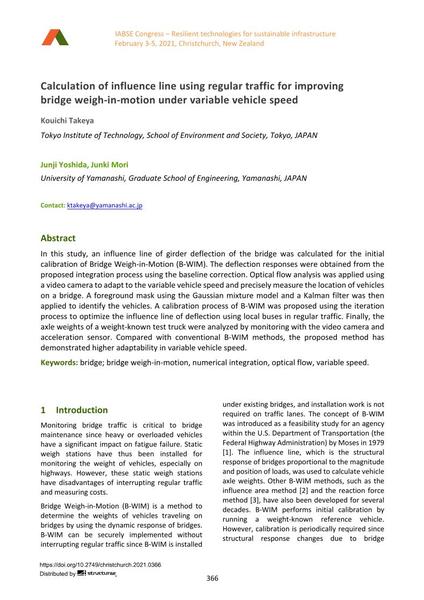Calculation of influence line using regular traffic for improving bridge weigh-in-motion under variable vehicle speed

|
|
|||||||||||
Bibliographic Details
| Author(s): |
Kouichi Takeya
(Tokyo Institute of Technology, School of Environment and Society, Tokyo, JAPAN)
Junji Yoshida (University of Yamanashi, Graduate School of Engineering, Yamanashi, JAPAN) Junki Mori (University of Yamanashi, Graduate School of Engineering, Yamanashi, JAPAN) |
||||
|---|---|---|---|---|---|
| Medium: | conference paper | ||||
| Language(s): | English | ||||
| Conference: | IABSE Congress: Resilient technologies for sustainable infrastructure, Christchurch, New Zealand, 3-5 February 2021 | ||||
| Published in: | IABSE Congress Christchurch 2020 | ||||
|
|||||
| Page(s): | 366-373 | ||||
| Total no. of pages: | 8 | ||||
| DOI: | 10.2749/christchurch.2021.0366 | ||||
| Abstract: |
In this study, an influence line of girder deflection of the bridge was calculated for the initial calibration of Bridge Weigh-in-Motion (B-WIM). The deflection responses were obtained from the proposed integration process using the baseline correction. Optical flow analysis was applied using a video camera to adapt to the variable vehicle speed and precisely measure the location of vehicles on a bridge. A foreground mask using the Gaussian mixture model and a Kalman filter was then applied to identify the vehicles. A calibration process of B-WIM was proposed using the iteration process to optimize the influence line of deflection using local buses in regular traffic. Finally, the axle weights of a weight-known test truck were analyzed by monitoring with the video camera and acceleration sensor. Compared with conventional B-WIM methods, the proposed method has demonstrated higher adaptability in variable vehicle speed. |
||||
| Keywords: |
bridge bridge weigh-in-motion numerical integration optical flow variable speed
|
||||
